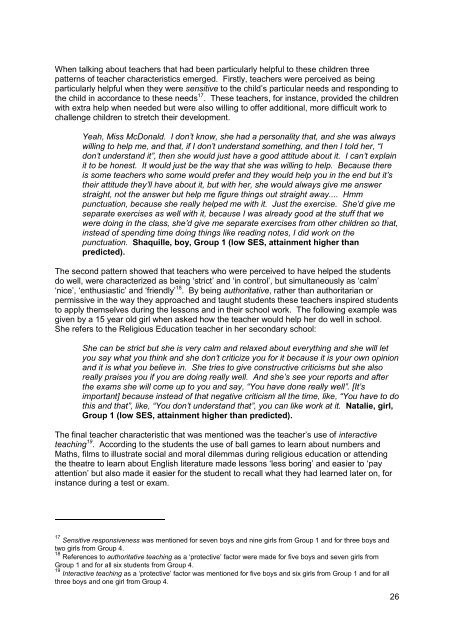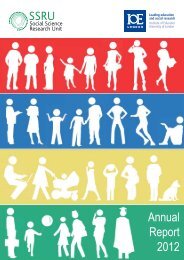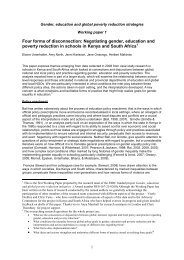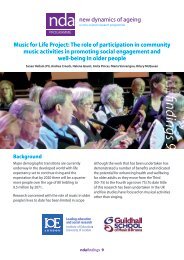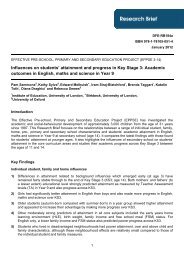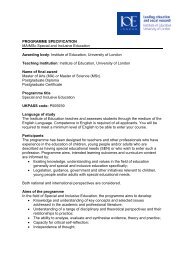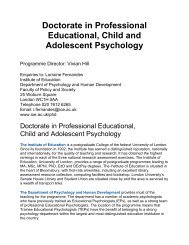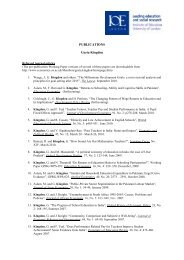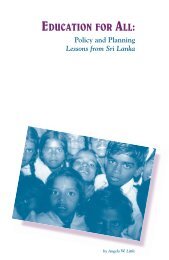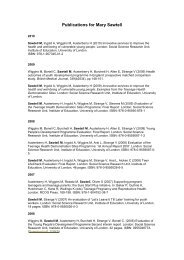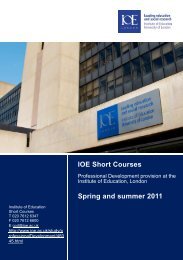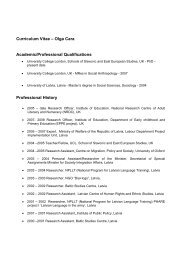Research report - Institute of Education, University of London
Research report - Institute of Education, University of London
Research report - Institute of Education, University of London
You also want an ePaper? Increase the reach of your titles
YUMPU automatically turns print PDFs into web optimized ePapers that Google loves.
When talking about teachers that had been particularly helpful to these children three<br />
patterns <strong>of</strong> teacher characteristics emerged. Firstly, teachers were perceived as being<br />
particularly helpful when they were sensitive to the child‟s particular needs and responding to<br />
the child in accordance to these needs 17 . These teachers, for instance, provided the children<br />
with extra help when needed but were also willing to <strong>of</strong>fer additional, more difficult work to<br />
challenge children to stretch their development.<br />
Yeah, Miss McDonald. I don‟t know, she had a personality that, and she was always<br />
willing to help me, and that, if I don‟t understand something, and then I told her, “I<br />
don‟t understand it”, then she would just have a good attitude about it. I can‟t explain<br />
it to be honest. It would just be the way that she was willing to help. Because there<br />
is some teachers who some would prefer and they would help you in the end but it‟s<br />
their attitude they‟ll have about it, but with her, she would always give me answer<br />
straight, not the answer but help me figure things out straight away.... Hmm<br />
punctuation, because she really helped me with it. Just the exercise. She‟d give me<br />
separate exercises as well with it, because I was already good at the stuff that we<br />
were doing in the class, she‟d give me separate exercises from other children so that,<br />
instead <strong>of</strong> spending time doing things like reading notes, I did work on the<br />
punctuation. Shaquille, boy, Group 1 (low SES, attainment higher than<br />
predicted).<br />
The second pattern showed that teachers who were perceived to have helped the students<br />
do well, were characterized as being „strict‟ and „in control‟, but simultaneously as „calm‟<br />
„nice‟, „enthusiastic‟ and „friendly‟ 18 . By being authoritative, rather than authoritarian or<br />
permissive in the way they approached and taught students these teachers inspired students<br />
to apply themselves during the lessons and in their school work. The following example was<br />
given by a 15 year old girl when asked how the teacher would help her do well in school.<br />
She refers to the Religious <strong>Education</strong> teacher in her secondary school:<br />
She can be strict but she is very calm and relaxed about everything and she will let<br />
you say what you think and she don‟t criticize you for it because it is your own opinion<br />
and it is what you believe in. She tries to give constructive criticisms but she also<br />
really praises you if you are doing really well. And she‟s see your <strong>report</strong>s and after<br />
the exams she will come up to you and say, “You have done really well”. [It‟s<br />
important] because instead <strong>of</strong> that negative criticism all the time, like, “You have to do<br />
this and that”, like, “You don‟t understand that”, you can like work at it. Natalie, girl,<br />
Group 1 (low SES, attainment higher than predicted).<br />
The final teacher characteristic that was mentioned was the teacher‟s use <strong>of</strong> interactive<br />
teaching 19 . According to the students the use <strong>of</strong> ball games to learn about numbers and<br />
Maths, films to illustrate social and moral dilemmas during religious education or attending<br />
the theatre to learn about English literature made lessons „less boring‟ and easier to „pay<br />
attention‟ but also made it easier for the student to recall what they had learned later on, for<br />
instance during a test or exam.<br />
17 Sensitive responsiveness was mentioned for seven boys and nine girls from Group 1 and for three boys and<br />
two girls from Group 4.<br />
18 References to authoritative teaching as a „protective‟ factor were made for five boys and seven girls from<br />
Group 1 and for all six students from Group 4.<br />
19 Interactive teaching as a „protective‟ factor was mentioned for five boys and six girls from Group 1 and for all<br />
three boys and one girl from Group 4.<br />
26


